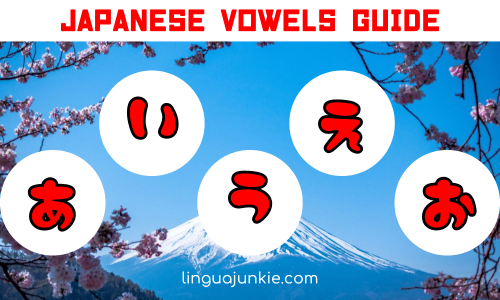Want to learn about Japanese vowels?
Like, what are long vowels and small vowels?
And how do you pronounce them properly? Well, in this quick guide, you’ll learn all about Japanese vowels in the next 3 minutes. This guide is spilt up into…
- Introduction to Japanese vowels
- Small vowels vs. long vowels and how to pronounce them
- And…a handy Japanese vowel chart.

1. Intro to Japanese vowels
Japanese is a relatively easy language to pronounce because the vowel sounds are easy. They have five main sounds:
- あ(a) — pronounced: ah
- い(i) — pronounced: ee
- う(u) — pronounced: oo
- え(e) — pronounced: eh
- お(o) – — pronounced: oh
Now, if you think of English, an “a” in English is pronounced in a wide variety of ways. For example, the “a” in “cat” and “cartoon” have very different sounds.
How Japanese Vowels Differ From English
But in Japanese, the “a” sounds the same no matter the context. For example, かめ(kame) and さる(saru) have different written characters but their pronunciation of the “a” is essentially the same. In general, the Japanese written language bundles consonants and vowels together, but the vowels still have a similar sound to each other. ら (ra) and さ (sa) are written differently but have the same “a” sound.
2. Small vowels vs. long vowels
Japanese Small vowels
There are five main small or short vowels in Japanese called 短母音 (tan boin).
As you now know, Japanese vowels of the same type are usually pronounced the same. Unlike in English, you don’t have to memorize the way a vowel is pronounced depending on the situation. For example, the “i” in “fit” and “fight” are pronounced differently in English, right?
So, here are the Japanese small vowel sounds with similar words in English. Although English vowels can sound similar to the Japanese vowel, it’s important to understand that the Japanese pronunciation can be drier and shorter.
- あ – a
The “a” sound is like the vowel sound in “ah”
- い – i
The “i” sound is like the vowel sound in “he”
- う – u
The “u” sound is like the vowel sound in “sue”
- え – e
The “e” sound is like the vowel sound in “egg”
- お – o
The “o” sound is like the vowel sound in “so”
Japanese Long vowels
In Japanese, the long vowels are called 長母音(chou boin) and are just lengthened versions of the short vowels. For example, the hiragana character か (ka) includes the “a” sounding vowel. If this hiragana character is combined with another “a” it becomes a long vowel. The word おかあさん (okaasan), meaning mother, has the long vowel “a” sound.
For borrowed words from other languages you’ll sometimes see a line “ー” that indicates that the vowel is held out longer during that time. In the word ラーメン(raamen) , a borrowed word from Chinese, the “a” sound is held out using the line. Another example would be スキー (sukii), meaning “ski”, where the last “i” is held out longer.
It’s also possible that two different vowels combine together to form a longer version. The word for “love”, あい (ai), is a combination of two vowel sounds. In this case, you only need to pronounce it exactly as written. You should add the sound for “a” with the sound for “i.
However, there is one exception to this rule. When the “o” and “u” vowel sounds combine, it creates a sound more similar to a long “o” vowel. The word こうこう (koukou), is mostly a long “o” vowel sound with a slight “u” sound toward the end.
Here are some more long vowel words in Japanese:
- おばあさん – obaasan (grandma)
Long vowel “a”
- クーラー- kuuraa (air conditioner)
Long vowels “u” and “a”
- ほしい – hoshii (to want)
Long vowel “i”
- オープンカー – oopunkaa (convertible)
Long vowels “o” and “a”
- ケース – keesu (case)
Long vowel “e”
3. Japanese Vowel Chart
In Japanese writing, the vowels are usually paired with a consonant sound. So, if you learn the Japanese alphabet, you automatically master both the Japanese vowels and Japanese consonants.
But, if you need a chart along with the sounds, take a look below.
This vowel chart organizes the hiragana writing based on the vowel sound.
| a | i | u | e | o |
| あ (a) | い (i) | う (u) | え (e) | お (o) |
| か (ka) | き (ki) | く (ku) | け (ke) | こ (ko) |
| さ (sa) | し (shi) | す (su) | せ (se) | そ (so) |
| た (ta) | ち (chi) | つ (tsu) | て (te) | と (to) |
| な (na) | に (ni) | ぬ (nu) | ね (ne) | の (no) |
| は (ha) | ひ (hi) | ふ (fu) | へ (he) | ほ (ho) |
| ま (ma) | み (mi) | む (mu) | め (me) | も (mo) |
| や (ya) | ゆ (yu) | よ (yo) | ||
| ら (ra) | り (ri) | る (ru) | れ (re) | ろ (ro) |
| わ (wa) | を (o) |
Conclusion – Back to You
Now you should know the basics of Japanese vowels and Japanese pronunciation.
And at this point, you likely know the whole Japanese alphabet too.
Leave me a comment and let me know if I answered all of your questions.
– The Main Lingua Junkie

this kinda helped me!